|

|
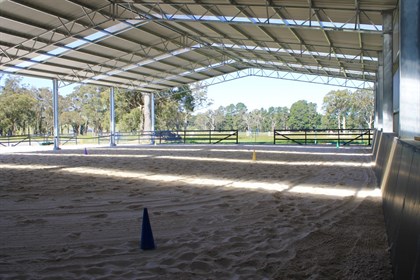
If you are planning on building a riding arena on your property, the first thing you need to consider is the size. Eureka Horse Wisdom in the Southern Highlands built a 30m x 20m covered arena with ABC Sheds, which provides a great protected space for training horses, and can be used in conjunction with an adjoining outdoor arena (read more below).
What size should I build my riding arena?
By Equestrian Life
If you are planning on building a riding arena on your property, the first thing you need to consider is the size. Of course, for many this does come down to available space and budget — but knowing the ideal arena size depending on your chosen equestrian activity is a great place to start.
General riding and training
When it comes to general riding and training, arena size really comes down to what you are planning on using it for. A 20m x 20m space allows you to work a horse on a decent sized circle, and this really is the bare minimum; generally, arenas this size are built as round yards and are often used for in-hand training such as lunging, and starting young horses. If you’re planning on riding or having multiple horses in work at once, will may something a little bigger.
Case studies:
Soo Woods, an equine therapy practitioner who runs Eureka Horse Wisdom in the Southern Highlands, built a 30m x 20m covered arena with ABC Sheds — and it was originally designed as a giant shelter for her herd! However, over time she has used it more and more as a training arena for her horses and clients where a lot of the training is groundwork — and it’s proven to be an ideal size for this purpose. With an open 30m x 20m sand yard running off the covered part of the arena, Soo has quite a large space in which she can work horses if needed — and she may extend the covered part in the future. This multi use space is an example of an arena that has evolved over time as its use has changed and shows that with clever planning it’s always possible to start smaller and expand if needed.
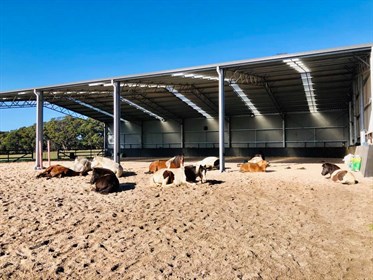
The 30m x 20m covered arena at Eureka Horse Wisdom forms part of a larger arena. It was originally designed as a giant shelter for the herd!
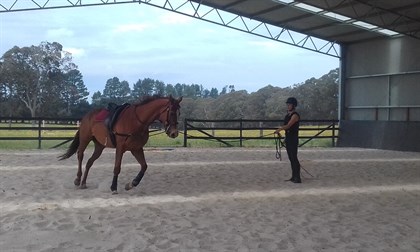
The 20m x 30m covered arena provides enough space for training.
Queensland based cattle farmer and horsemanship expert David Stuart also recently built a covered arena with ABC Sheds — largely to beat the harsh Nebo heat! David, who trains horses for clients and runs clinics, built a 20m x 20m arena cover as part of a larger training area. On hot summers days, the covered space is big enough to work with a horse, and also provides some shelter for clinics that often focus on groundwork. Being contsructed as part of a larger training area means there is additional space if required, but shelter on hand when it's hot.
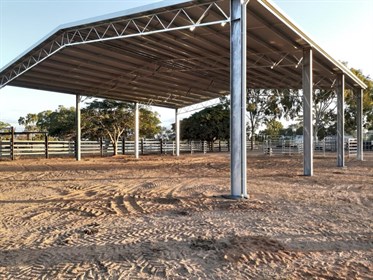
David Stuart's 20m x 20m cover is also part of a larger training arena.
Dressage
Most riders are familiar with the fact that an “Olympic size” dressage arena is 20m wide and 60m long; these dimensions are not limited to the Olympics of course, but are the standard size for the vast majority of competitions, including the dressage phase of eventing. 20m x 60m is the sized used for virtually all Equestrian Australia and FEI tests.
There are some exceptions, one being Equestrian Australia’s (EA) Preliminary tests — these give the option of being run in a 20m x 60m or a smaller 20m x 40m arena. Some Pony Club tests also use the smaller arena size, for example the Pony Club Association of Victoria stipulates that the Grade 6, 5 and 4 tests are to be ridden in a 20m x 40m arena. Grade I, II and III para dressage tests are also ridden in 20m x 40m arenas under both EA and Fédération Equestre Internationale (FEI) rules.
A 20m x 40m arena is really the smallest size you want to go if you’re training a dressage horse and it will facilitate the practice of most movements — however 20m x 60m is the ideal option if budget and space permits, as it means you can practice any dressage test.
Case study:
Robyne Smith of Gwandalan Stables in Scone recently converted her outdoor dressage arena to a covered arena with the help of ABC Sheds, opting to stick with the standard 20m x 60m Olympic sizing to ensure she could practice all tests and have space for working multiple horses at once. The cover is an impressive 28m x 66m, as it includes an additional bay at the end of the arena and a breezeway with stables down the side; when planning your arena, it often pays to think about what other facilities are required around it!
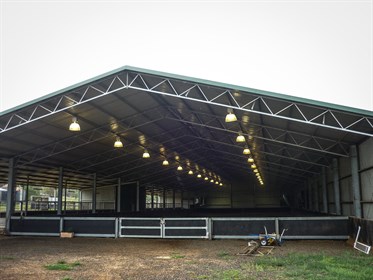
The covered dressage arena at Gwandalan Stables is 20m x 60m, however the actual structure is larger to accommodate stables, a breezeway and additional storage space.
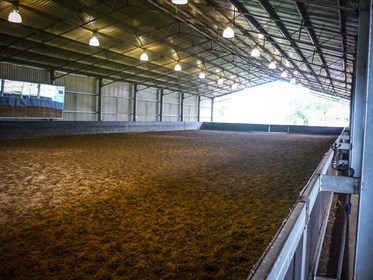
Gwandalan Stables has a 20m x 60m Olympic size dressage arena.
Show jumping
A 20m x 40m arena will provide enough space to set up a couple of jumps, however serious competitors who want to practice a range of different lines and courses will need something larger — especially if multiple horses are being worked at the one time. Some jumping arenas are as large as 60m x 100m, especially on bigger properties where large numbers of horses are being professionally schooled every day!
In terms of competitions, EA’s rules stipulate that for jumping events, indoor arenas must be a minimum of 1200 sqm and 20m on the short side (therefore a minimum of 20m x 60m), while outdoor arenas must be a minimum of 4000 sqm and 50m on the short side (50m x 80m). It is the same for the FEI, although the indoor must be a minimum width of 25m (25m x 48m).
Driving
When it comes to driving, it really does depend if you’re driving one, two or four horses. However, generally 40m x 60m is the smallest you will want to go; driving requires extra width compared to an arena used for riding.
According to the FEI, competition arenas need to be 40m x 100m for the dressage phase of combined driving events. However, a 40m x 80m arena is used in some instances, for example pony and youth classes, and some classifications of single and pairs events.
Western riding
If you’re involved in western pursuits, the ideal arena size really depends on what type of training you’re doing. If you’re roping you’ll need something around 33m x 65m and up, while cutting pens are generally squarer with the length and width starting from 30-35m and larger for competitions. When it comes to reining, the FEI recommends a minimum of 25m x 60m for competitions, with higher-level events having arenas as large as 40m x 80m.
Campdrafting arenas need to be larger, with the minimums set by the National Campdraft Association being 40m x 70m — however they are often much bigger at competitions.
Case study:
Queenslander Abe Graham, of Abe Graham Performance Horses, recently added an ABC Sheds covered arena to his new property. The 30m x 32m clear span fully galvanised shed is 5m high and allows Abe to work his horses out of the Rockhampton heat; he says as a rule on a hot day, it’s often eight degrees cooler on the arena compared to out in the sun! The fairly square dimensions provide ample space for working cutting horses and general training.
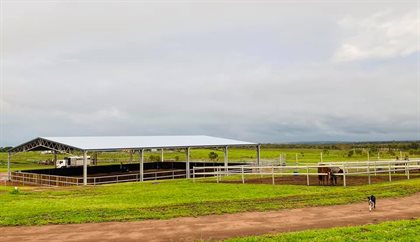
Abe Graham's 30m x 32m covered arena is largely used for training cutting horses.
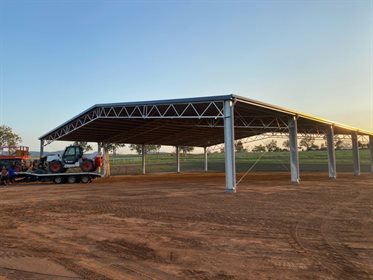
Abe Graham's arena was build by ABC Sheds.
So just how big can you build an arena?
When it comes to outdoor arenas, you’re really only limited by budget and space. However, if you’re looking to build a covered arena so you have some protection from the elements, then there are some limitations.
If a covered arena is too wide, the structure will need support poles to hold the roof up, which clearly isn’t conducive to horse riding! The team at ABC Sheds build fully engineered arena covers that can span up to 60m wide without the need for centre supports or even additional knee bracing. In terms of length, there are no limitations.
The good news is that all the arena sizes mentioned earlier in this article — whether it be for dressage, jumping, driving or western pursuits — can be created as covered arenas, so there is no need to trade protection and convenience for size. You can have both!
To find out more about building your dream covered riding arena, get in touch with ABC Sheds via their website, call 1800 44 55 68 or download their free ‘Equestrian Building Solutions’ brochure.
Click here to download the free 'Equestrian Building Solutions' brochure!

This article was written in conjunction with ABC Sheds.
READ THE LATEST NEWS ARTICLES HERE

|

|

